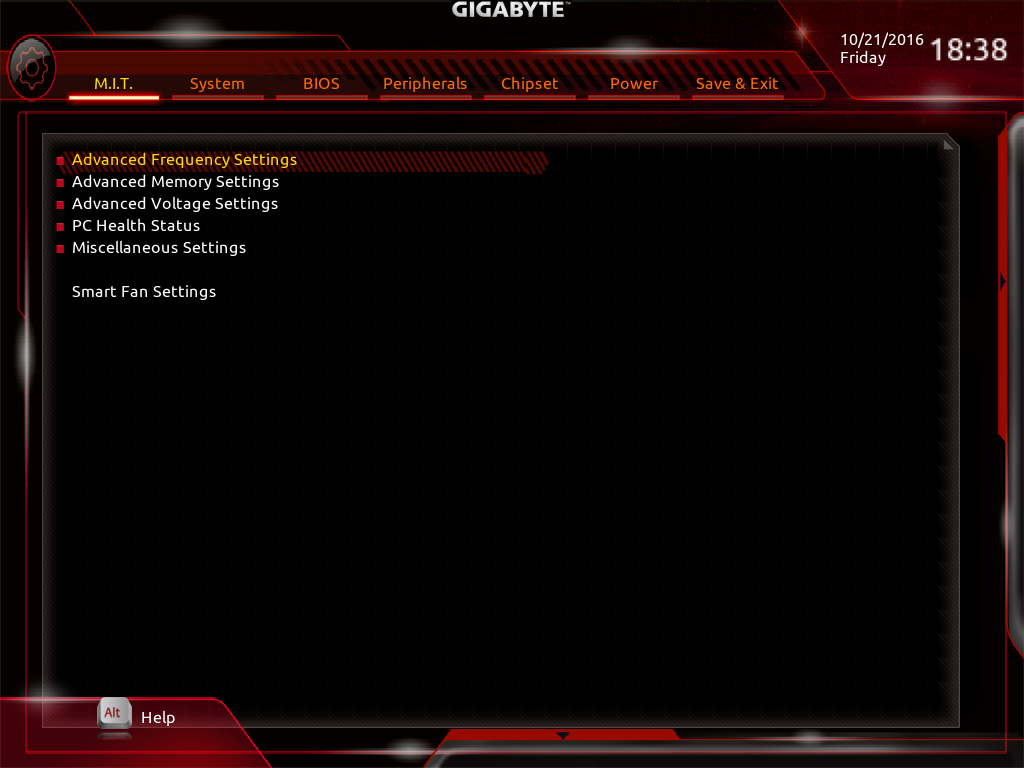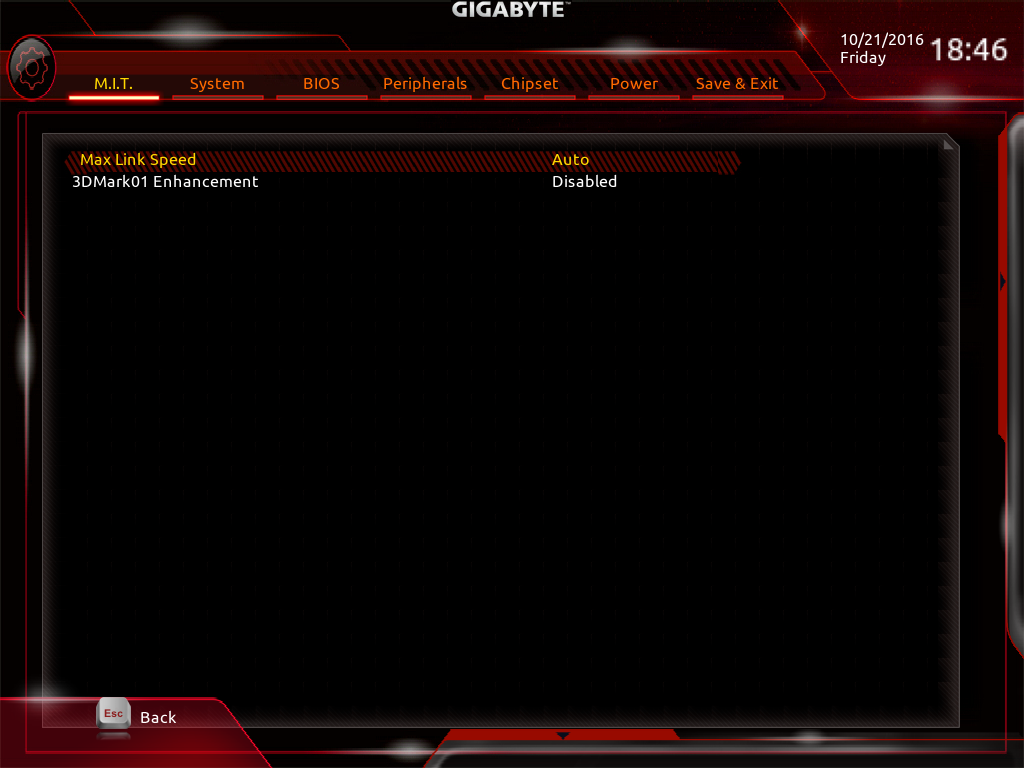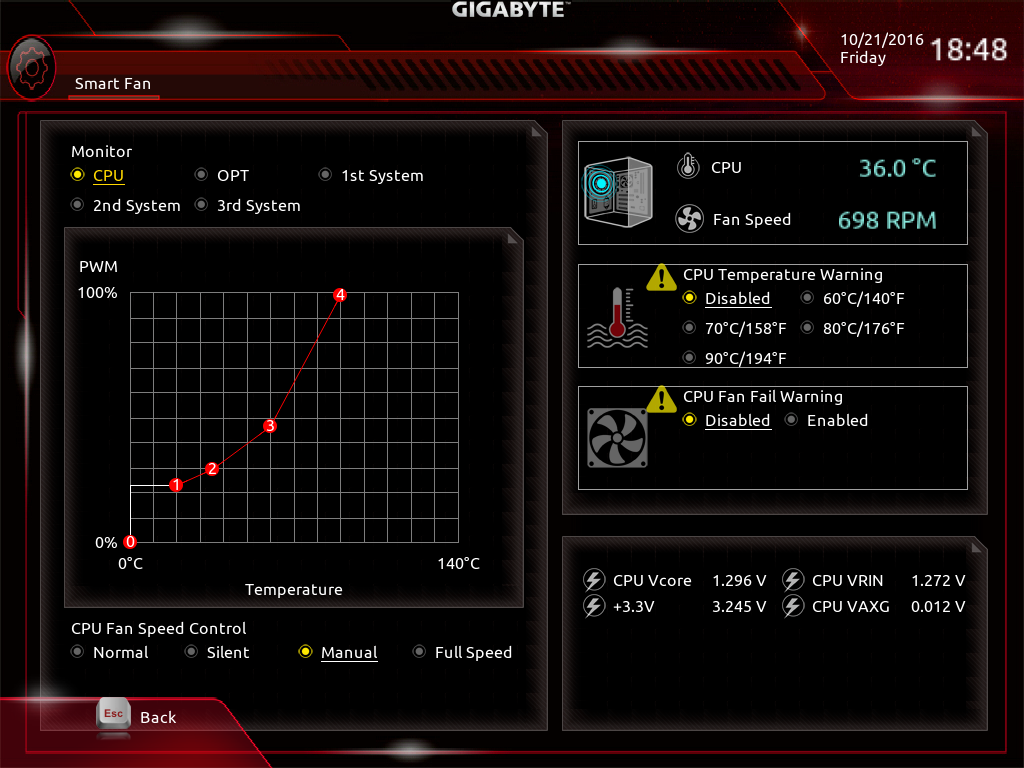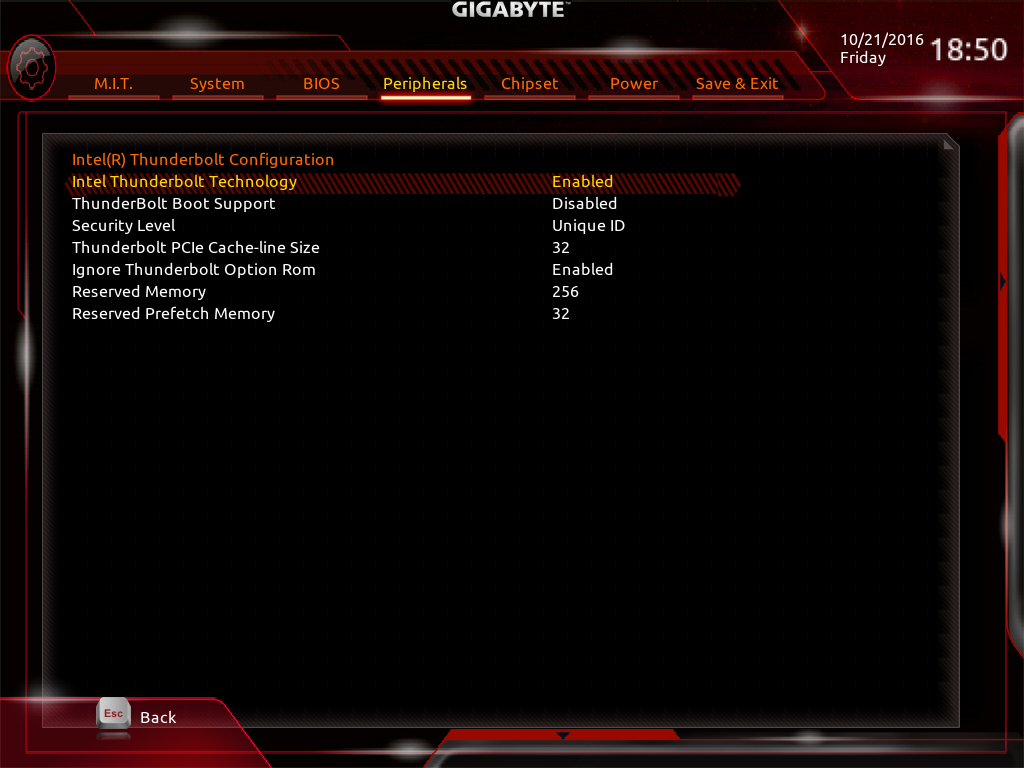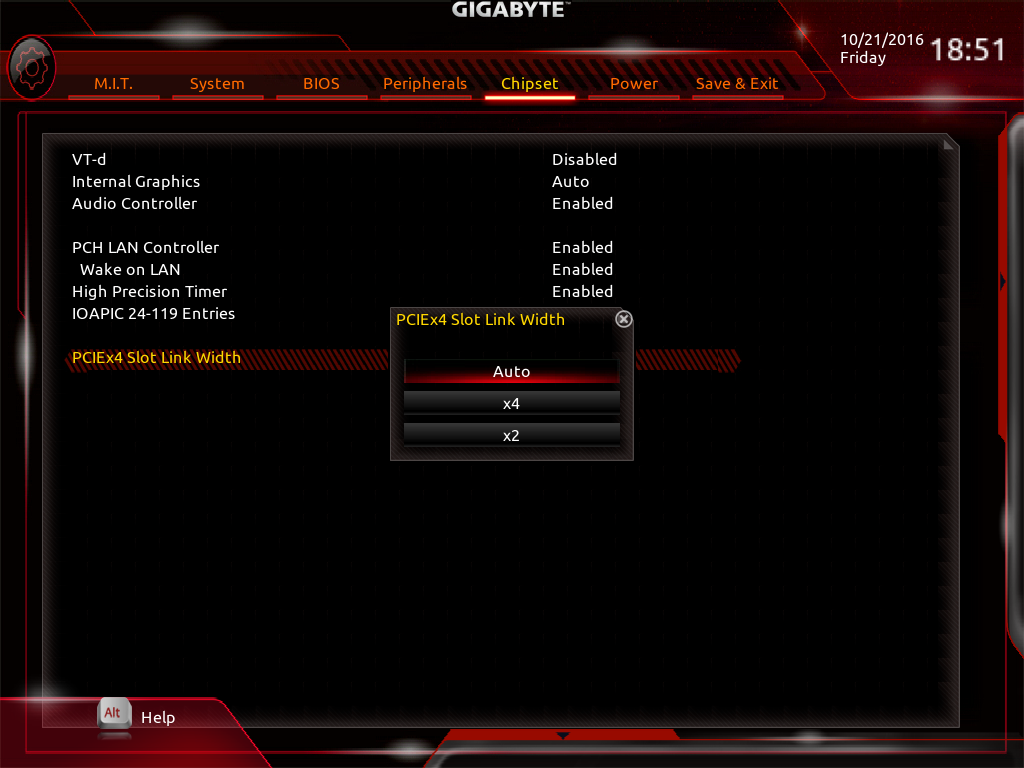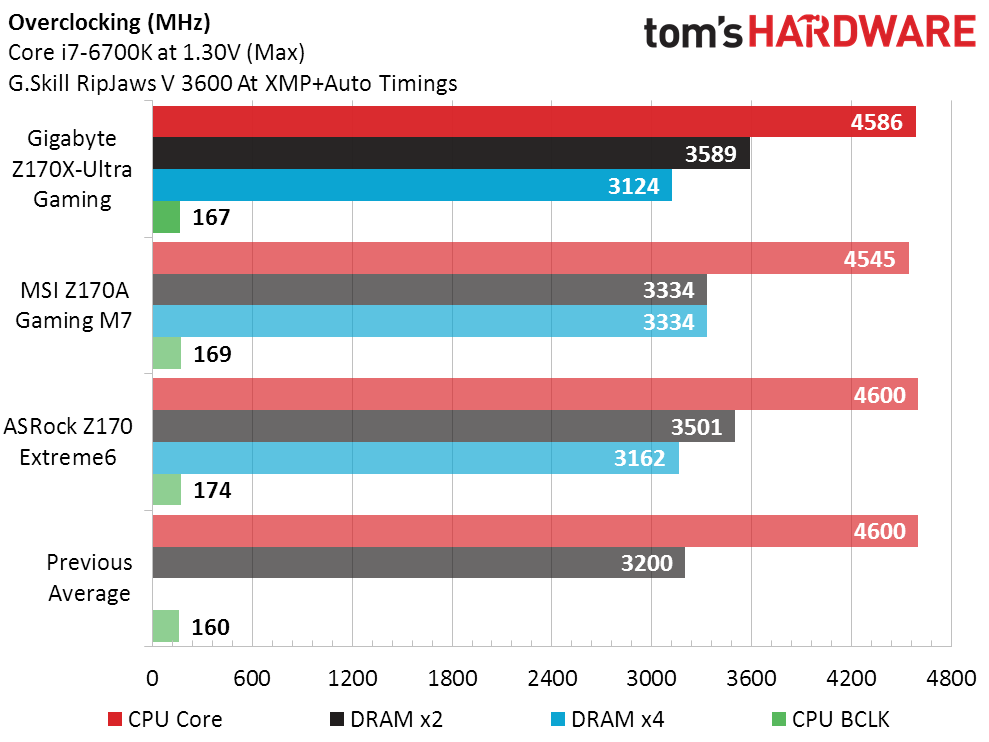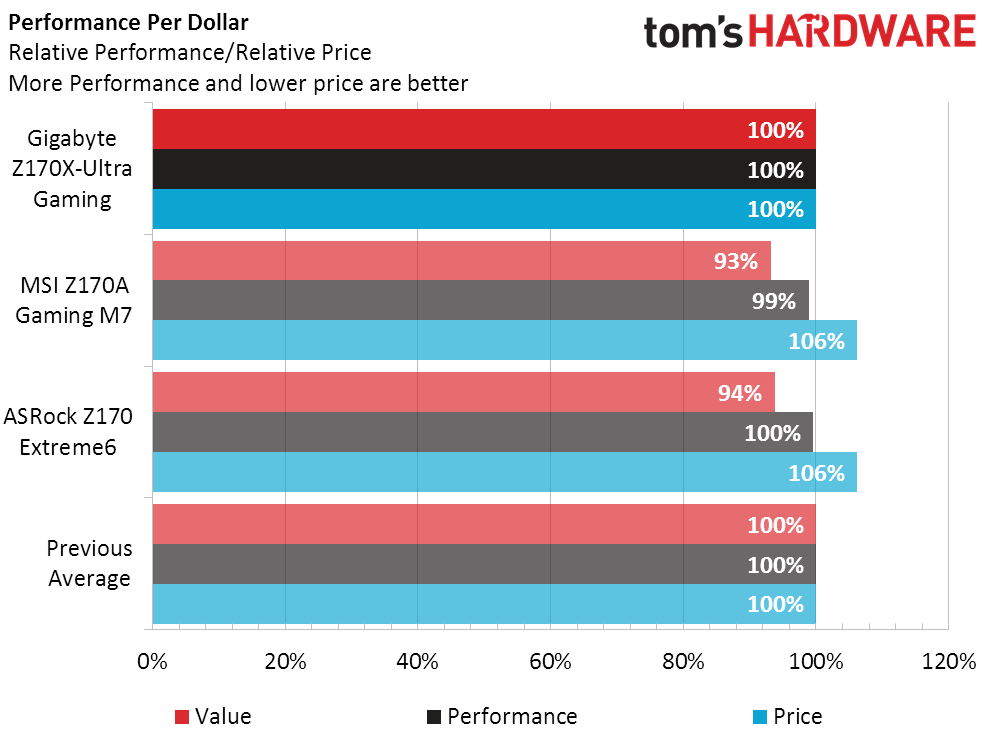Gigabyte Z170X-Ultra Gaming ATX Motherboard Review
Why you can trust Tom's Hardware
Z170X-Ultra Gaming Firmware And Overclocking
The Z170X-Ultra Gaming includes a wide enough range of settings to suit the needs of most overclockers, though actual tests will show how well these work:
| Frequency and Voltage settings | Gigabyte Z170-HD3 |
| BIOS | F5b (08/03/2016) |
| Base Clock | 80-500 MHz (10 kHz) |
| CPU Multiplier | 8x-127x (1x) |
| DRAM Data Rates | 800-4133 (100/133.3 MHz) |
| CPU Vcore | 0.60-1.80 V (5 mV) |
| System Agent | 0.80-1.30 V (5 mV) |
| CPU I/O | 0.80-1.30 V (5 mV) |
| PCH Voltage | 0.80-1.30 V (20 mV) |
| DRAM Voltage | 1.00-2.00 V (10 mV) |
| CAS Latency | 5-31 Cycles |
| tRCD | 1-63 Cycles |
| tRP | 1-63 Cycles |
| tRAS | 1-127 Cycles |
Gigabyte continues its multi-layered firmware GUI, confounding my efforts to reduce the number of screenshots required to show readers a specific motherboard’s specific functions. Yet both readers and writers with a modicum of patience are likely to find all of the required settings to reach their overclocking goals.
Gigabyte’s M.I.T. menu provides submenu access for system clocks, memory ratios and timings, various voltage controls, hardware monitoring, and fan controls.
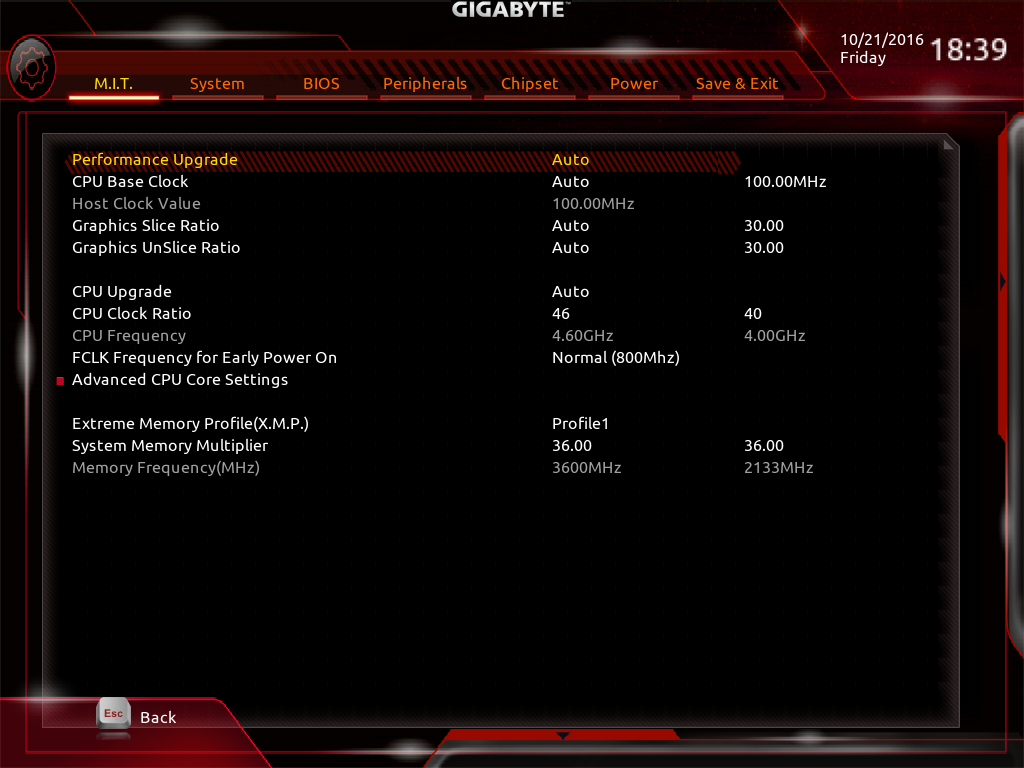


The Advanced Frequency Settings menu opens up to BCLK, CPU core and integrated graphics ratios, and a memory ratio setting that’s redundant to the actual memory menu. One submenu deeper we find an Intel Turbo Boost setting that, when set to disabled, locks in the set CPU ratio, even if the set ratio is actually a turbo ratio. Power limits and energy saving functions are also found within the deeper submenu.
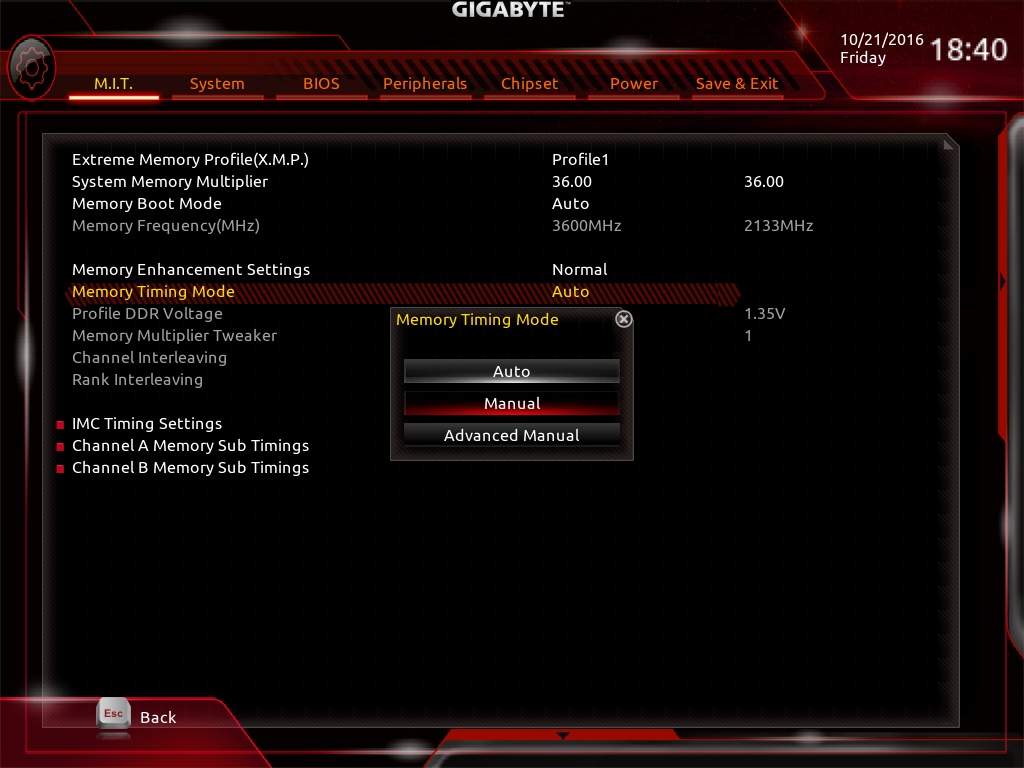


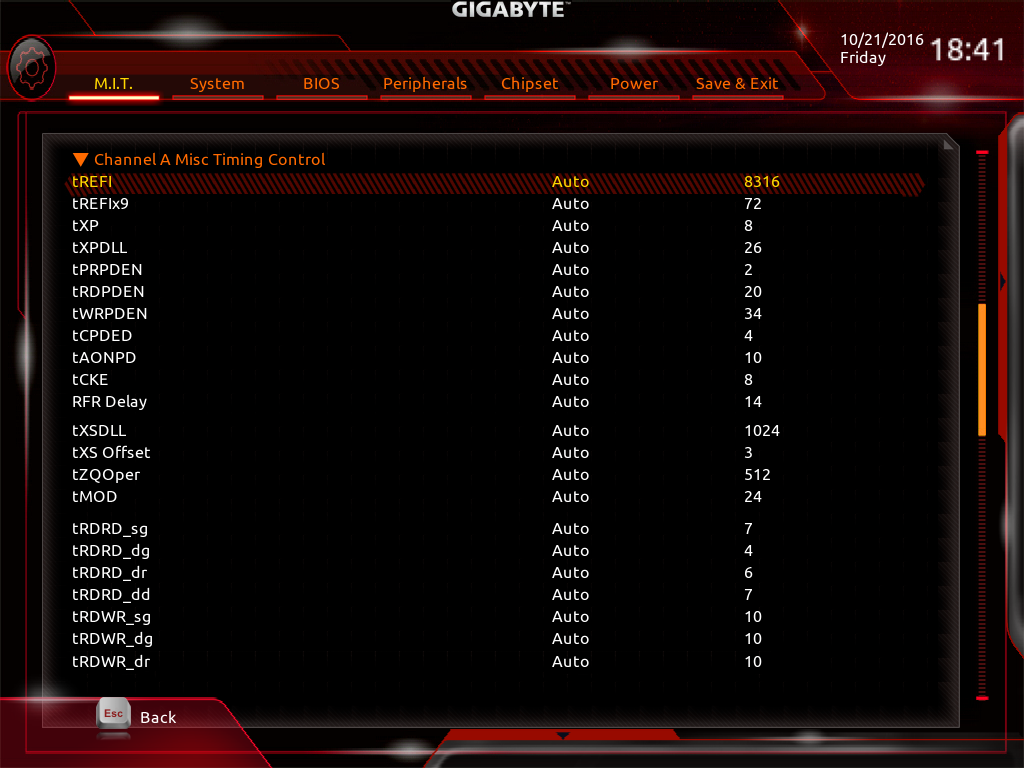

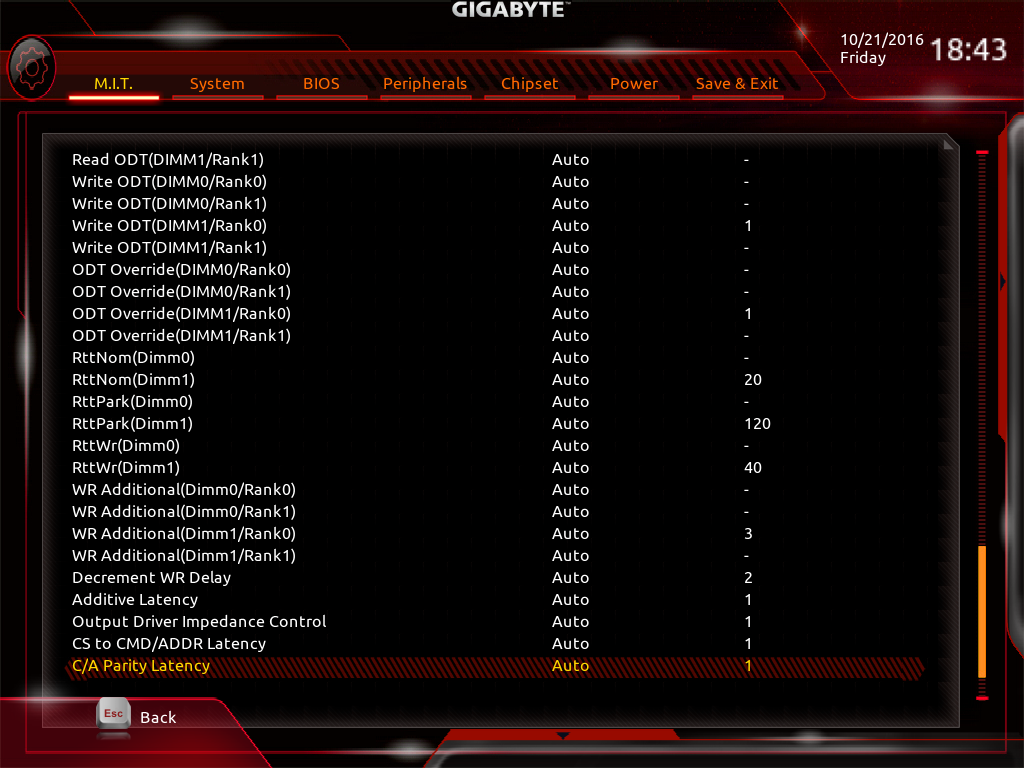
The Advanced Memory Settings submenu opens to XMP and ratio settings. Memory timings are adjustable in both-channel (Manual) and per-channel (Advanced Manual) modes. Memory controller settings are available, along with a full set of DRAM primary, secondary, and tertiary latencies.
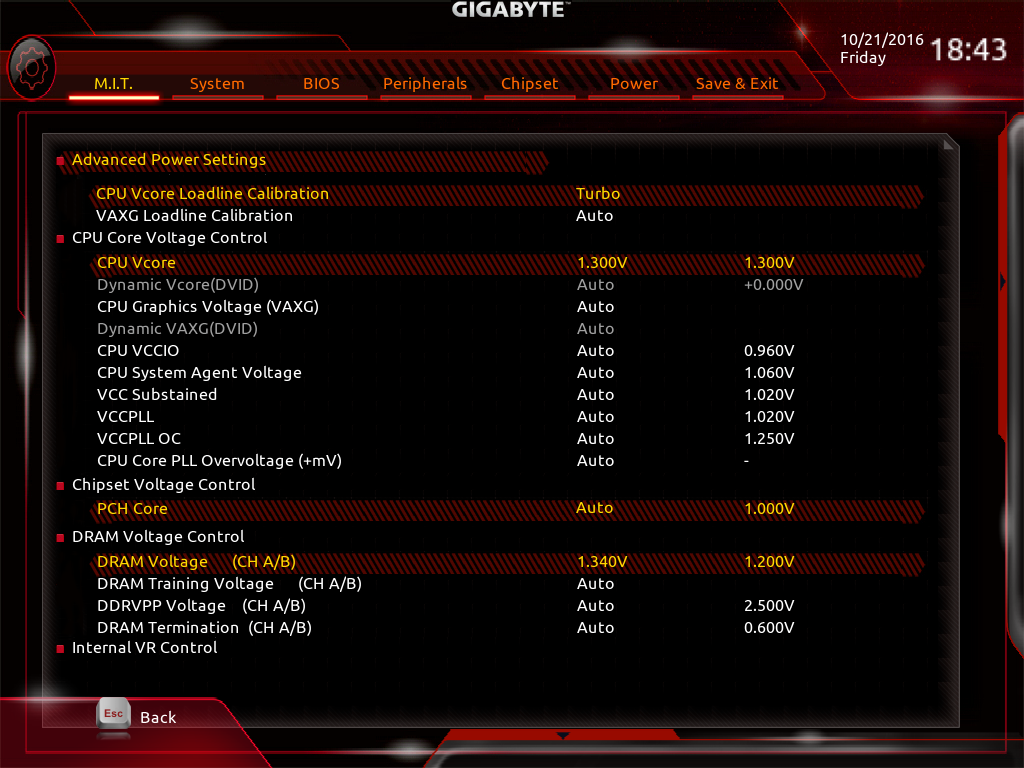
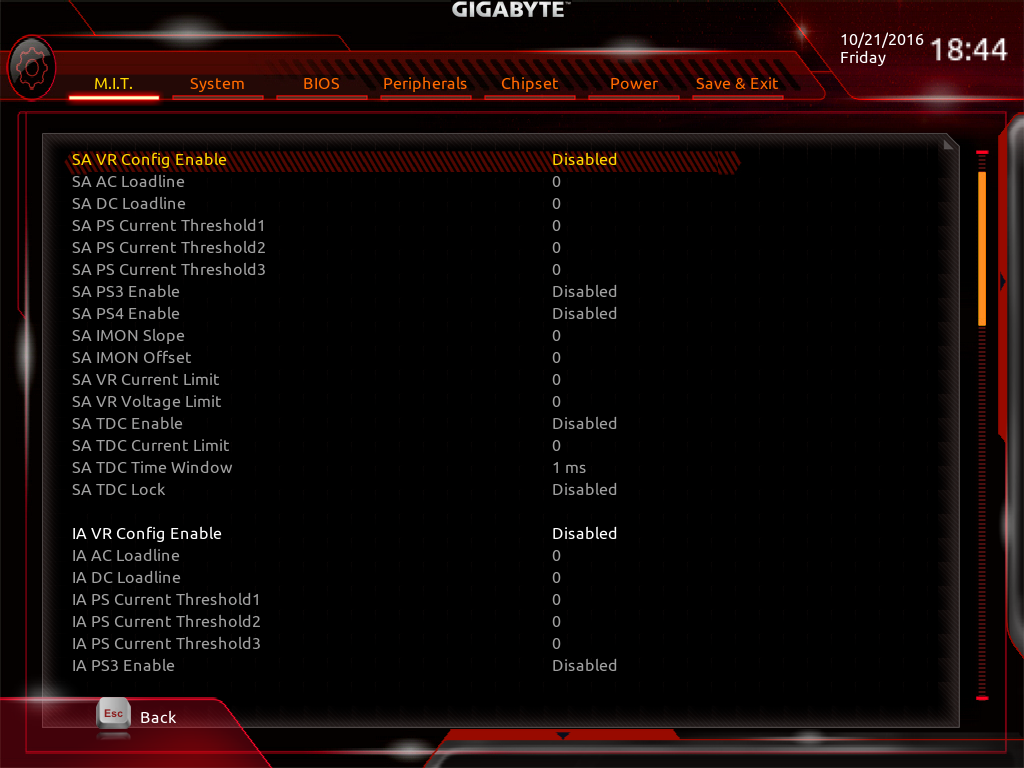
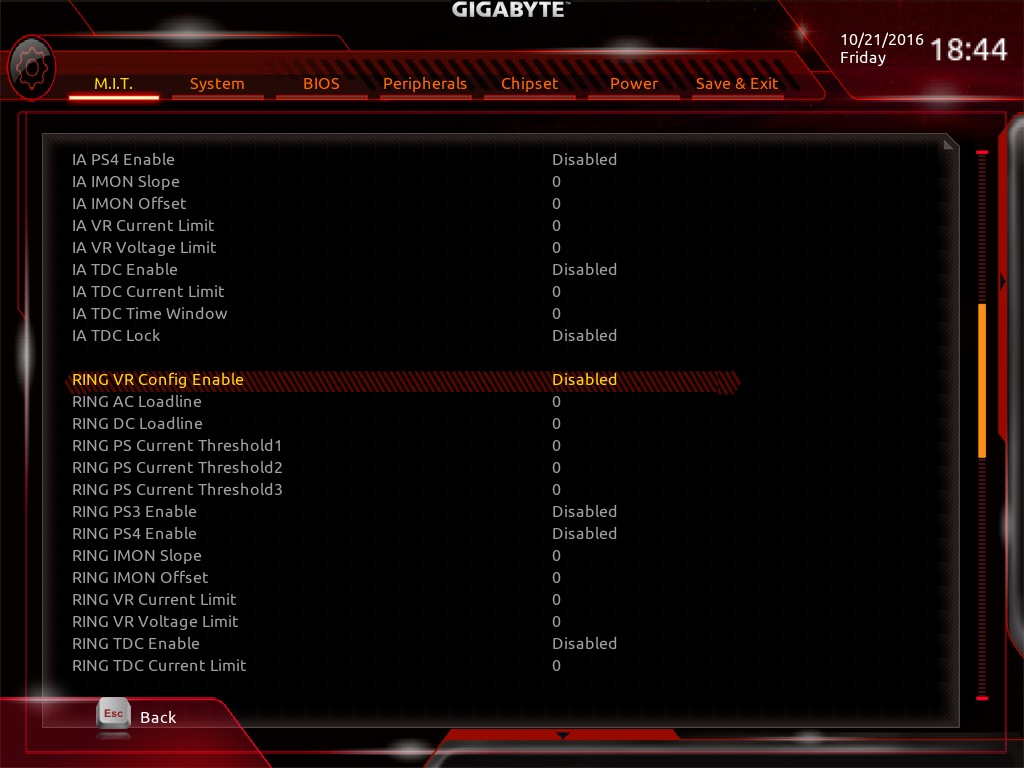

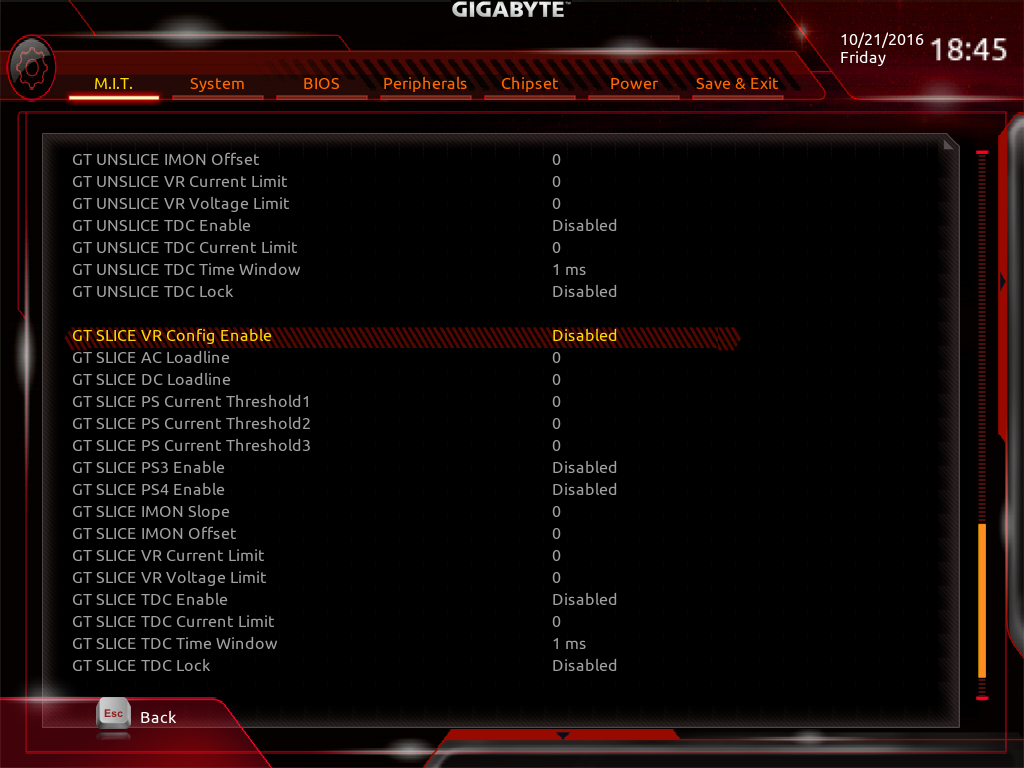
Did I mention that I really don’t like rummaging through submenus to find all the settings in a group, even when I’m just reading a review? Gigabyte won’t combine its primary voltage settings within a single submenu, but a little help from Photoshop allows me to illustrate these on a single image. The Advanced Power Settings submenu provides Loadline Calibration control, for which the highest “Turbo” setting kept our CPU sample between 1.296V and 1.308V at its 1.30V setting. The 1.340V DIMM setting produced 1.349V as read by our voltmeter, which is less over-voltage than most competing boards. Additional settings found under the Internal VR Control submenu include voltage regulator limits for non-core functions.
Gigabyte’s PC Health Status submenu shows just the basic stats, though the DRAM reported voltage is 17mV lower than our voltmeter indicates.
Get Tom's Hardware's best news and in-depth reviews, straight to your inbox.
That “Miscellaneous Settings” submenu from Gigabyte M.I.T.? It’s nothing more than a place to find the oddball 3DMark01 Enhancement setting.
Also a submenu of Gigabyte’s Motherboard Intelligent Tweaker, Smart Fan Control, provides options also available in software. Since some people never enter the firmware GUI and others don’t load the software, perhaps it’s good that we find it in both locations.
Interface and firmware settings for the Intel Thunderbolt 3 controller are found within a submenu of the Z170X-Ultra Gaming’s Peripherals menu.
The Chipset menu could be very important to people using advanced storage configurations, because two of the PCIe 3.0 x4 slots pathways share resources with two SATA ports. Reducing the slot to x2 mode frees the two SATA ports.
Test Results And Final Analysis
Using our latest Z170 test hardware and new standardized test suite, we're comparing Gigabyte’s Z170X-Ultra with two rivals that were the same price on the day testing commenced. Those two competitors have since increased in price, giving Gigabyte a $10 pricing advantage after recalculating value scores, and prices could change further by the time you read this.
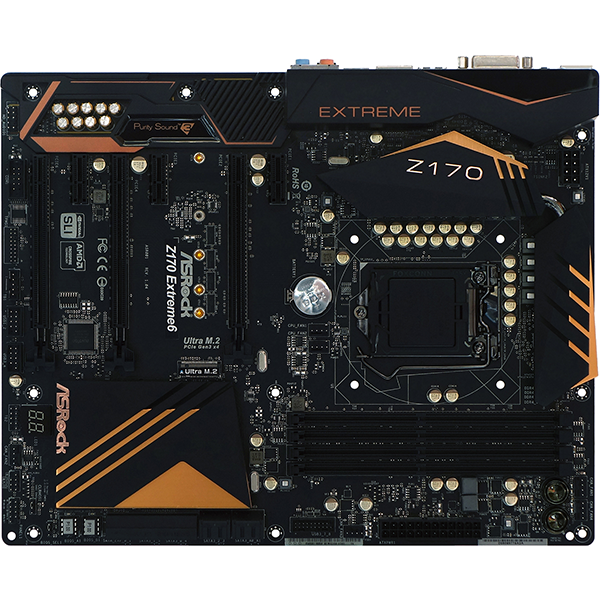
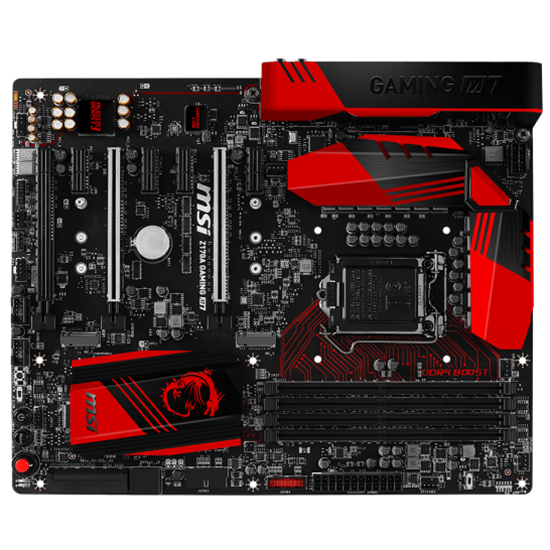
Synthetic Benchmarks
Synthetics are great for weeding out specific problems with specific components, but will be identical under ideal conditions. This is what we see in 3DMark, though PCMark shows a small deviation for the Z170A Gaming M7 in its Creative score. PCMark’s Storage metric evaluates the starting times of actual programs, and will be the only synthetic benchmark used in overall performance evaluation.
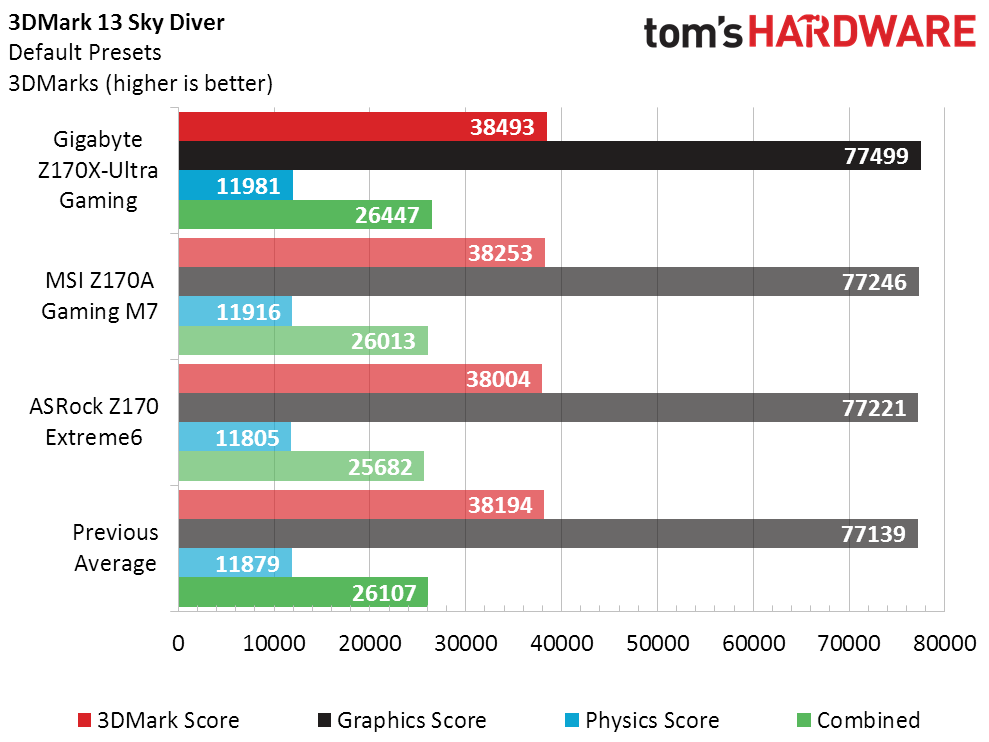
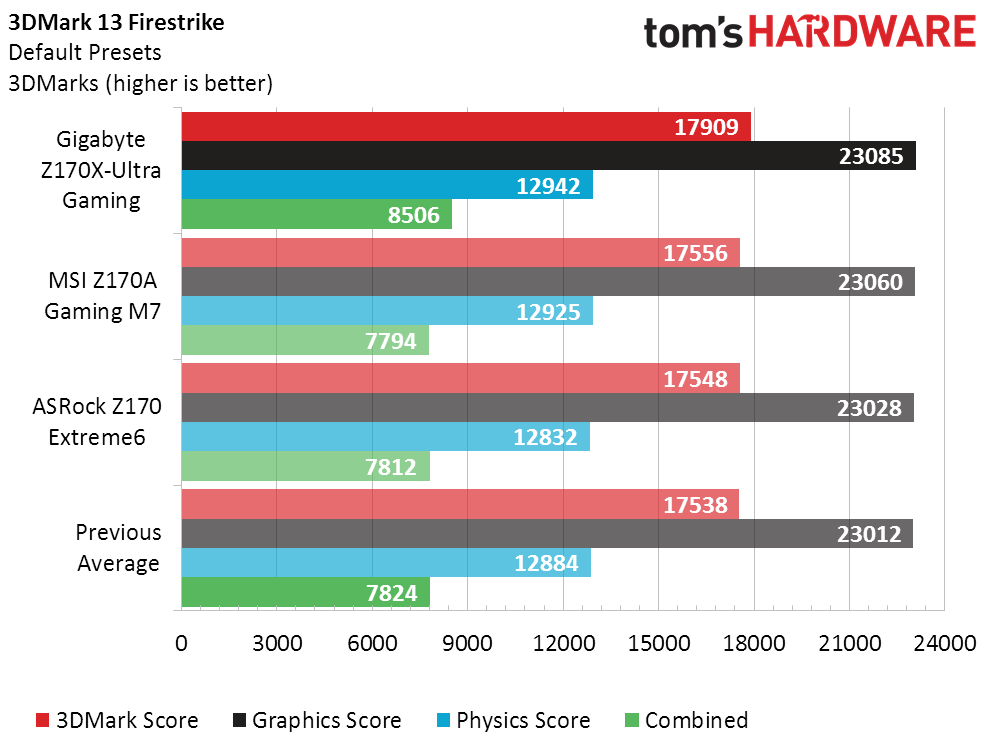
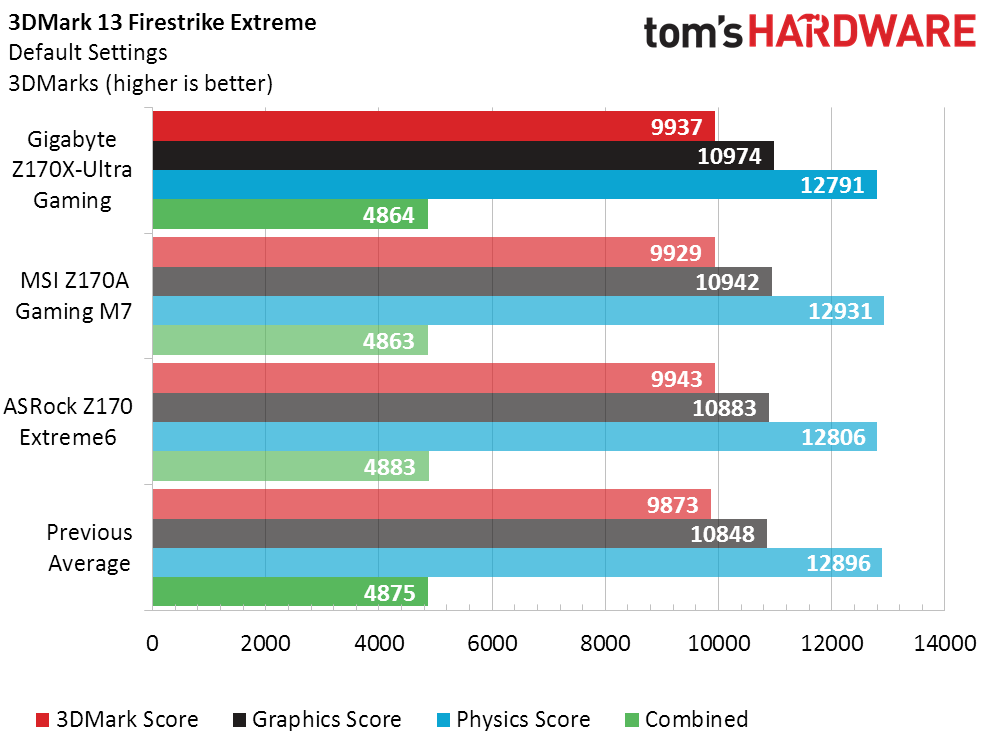
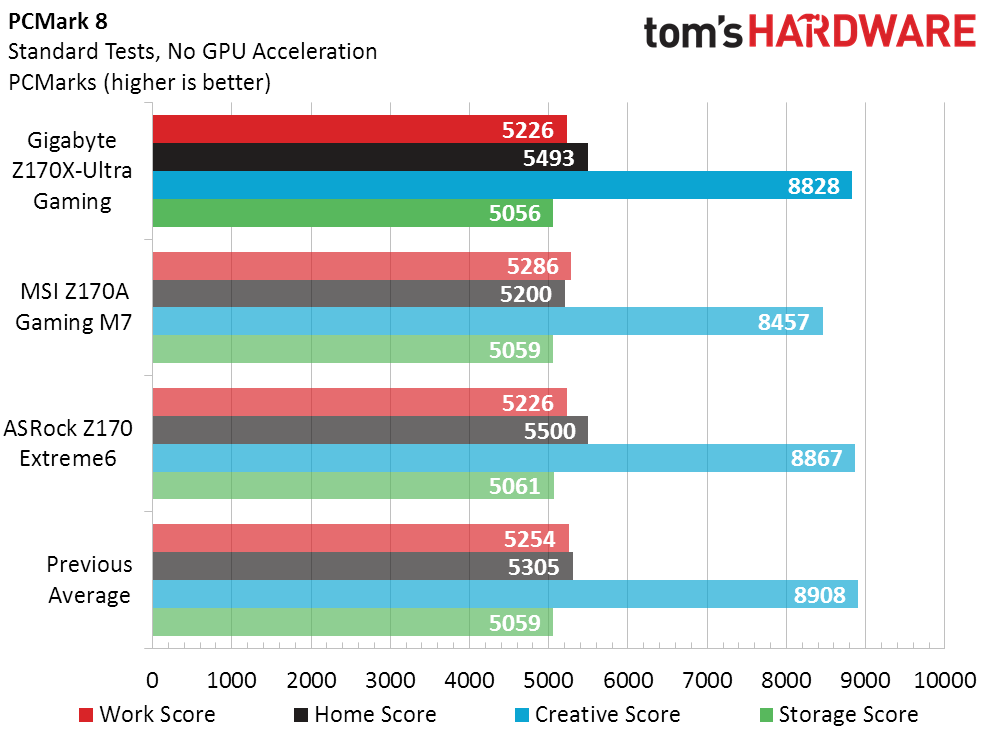



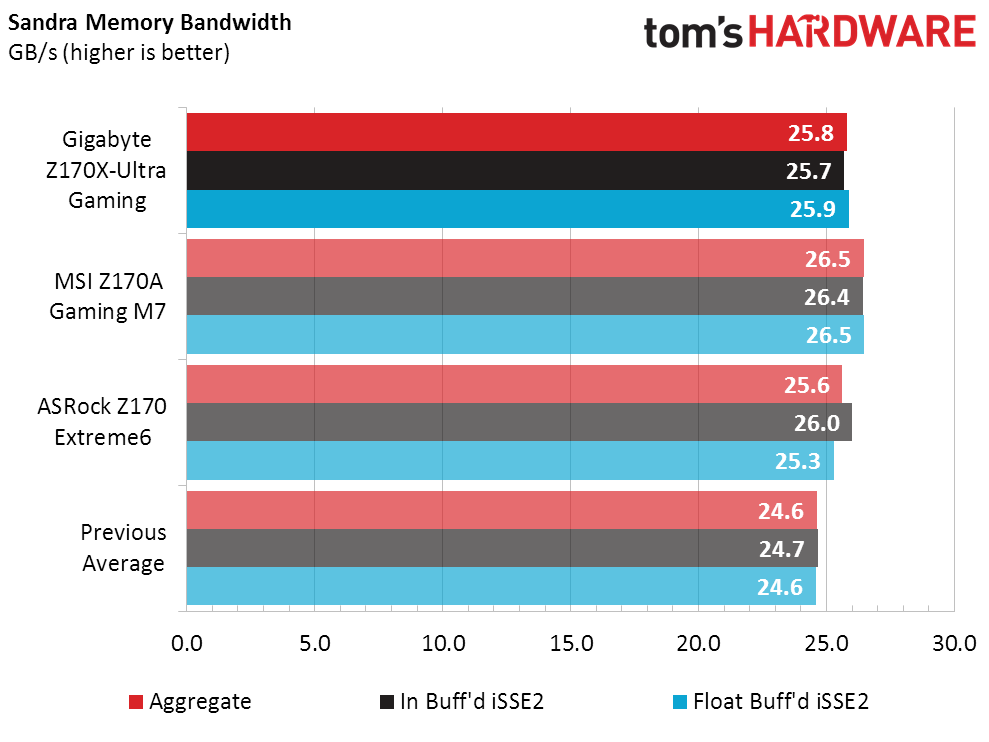
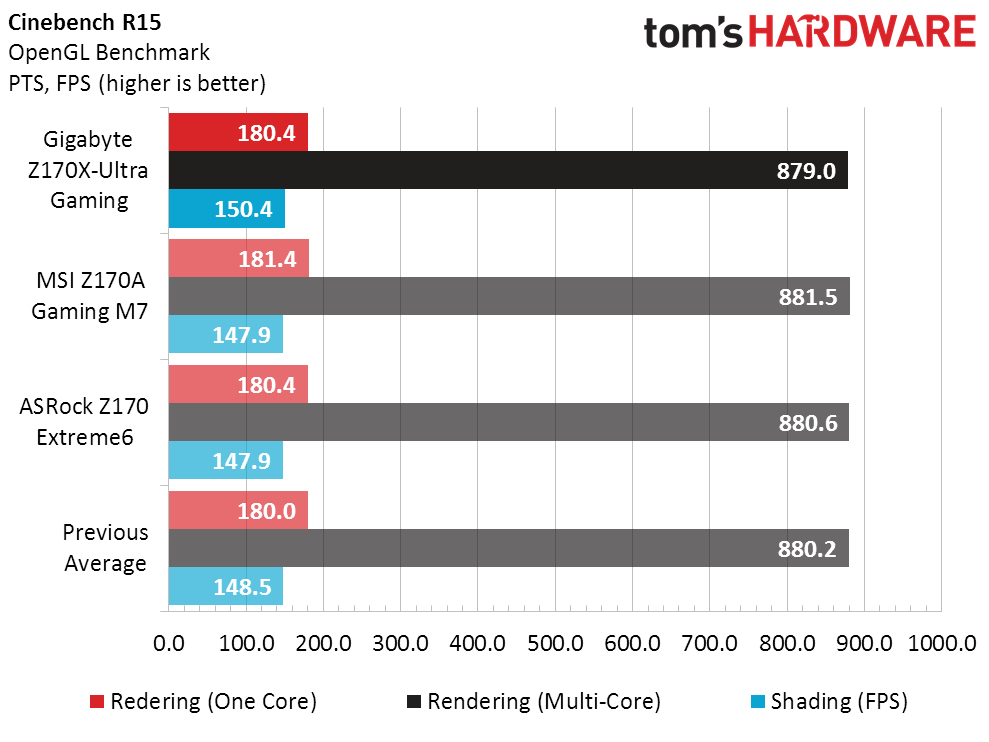
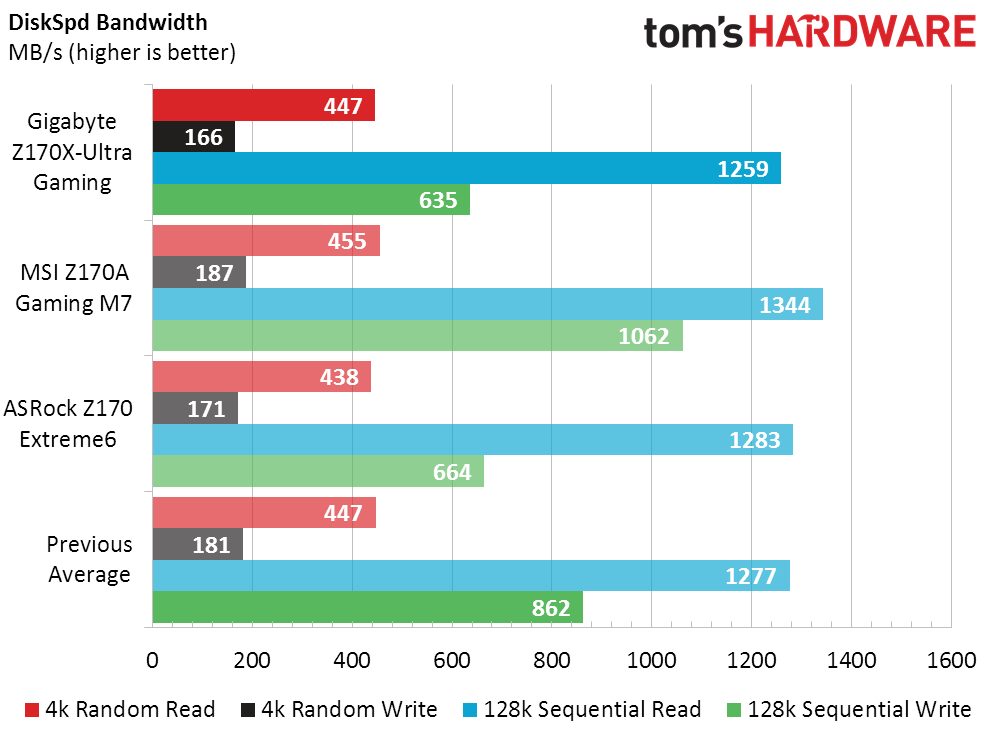
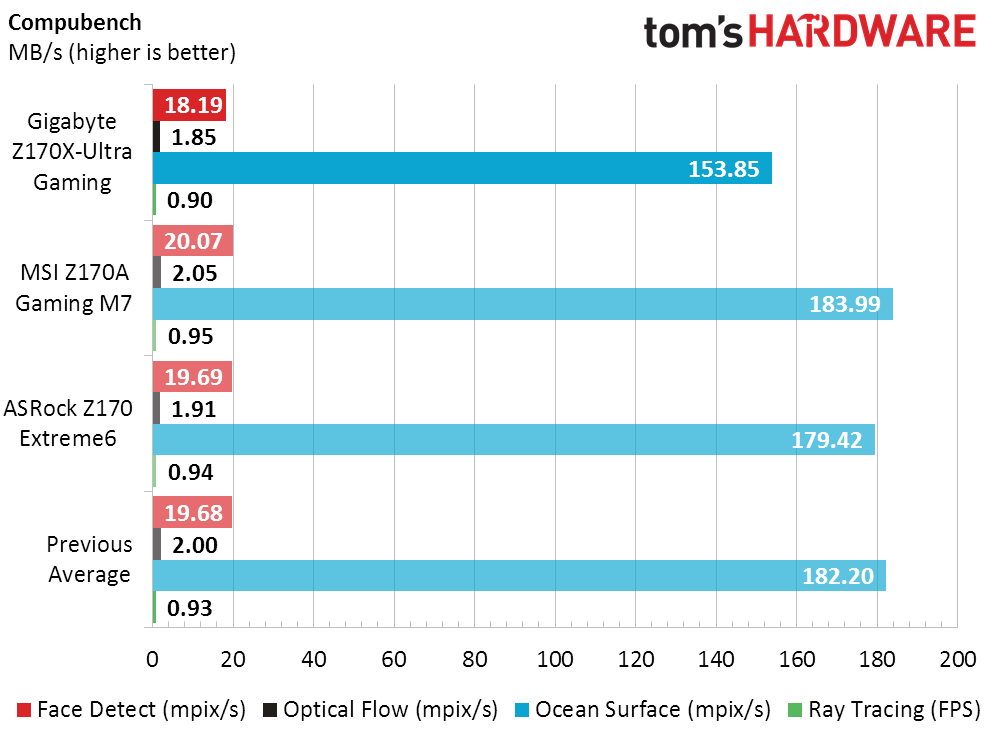
Compubench shows an odd slowdown for the Z170X-Ultra Gaming that’s not seen in other synthetics. The Previous Average includes two dual-slot systems, impacting Sandra Memory Bandwidth.
3D Games
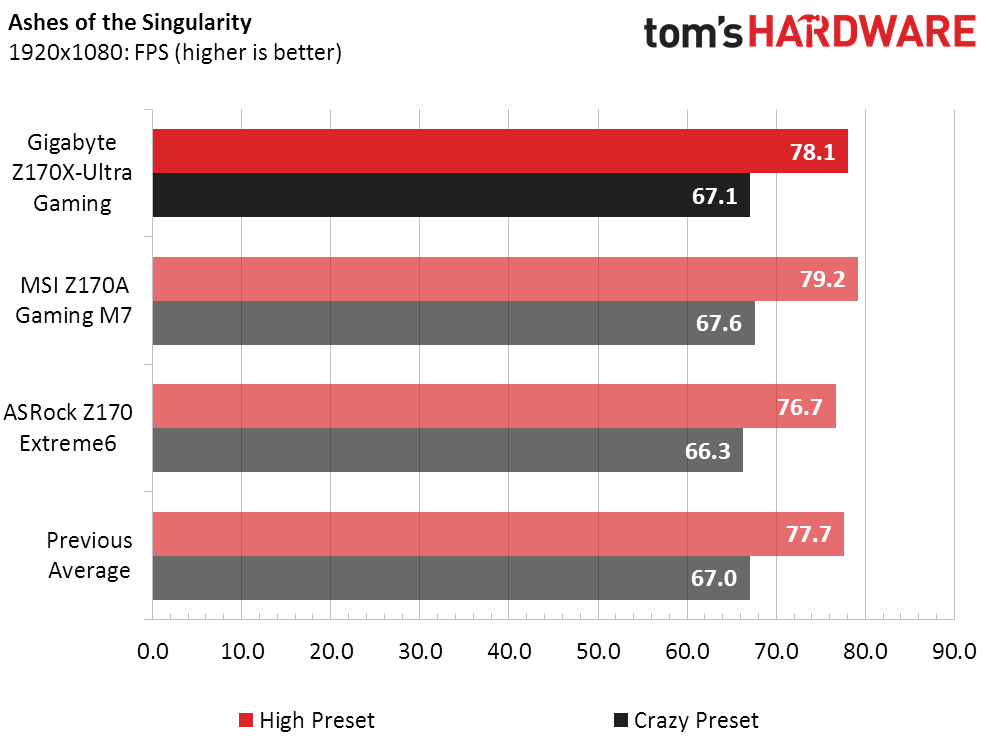



Gigabyte’s Z170X-Ultra Gaming battles MSI’s Z170X Ultra through the gaming suite, with ASRock’s Z170 Extreme6 taking a few wins on its own. The differences are too close to visually detect in actual game play.
Timed Applications
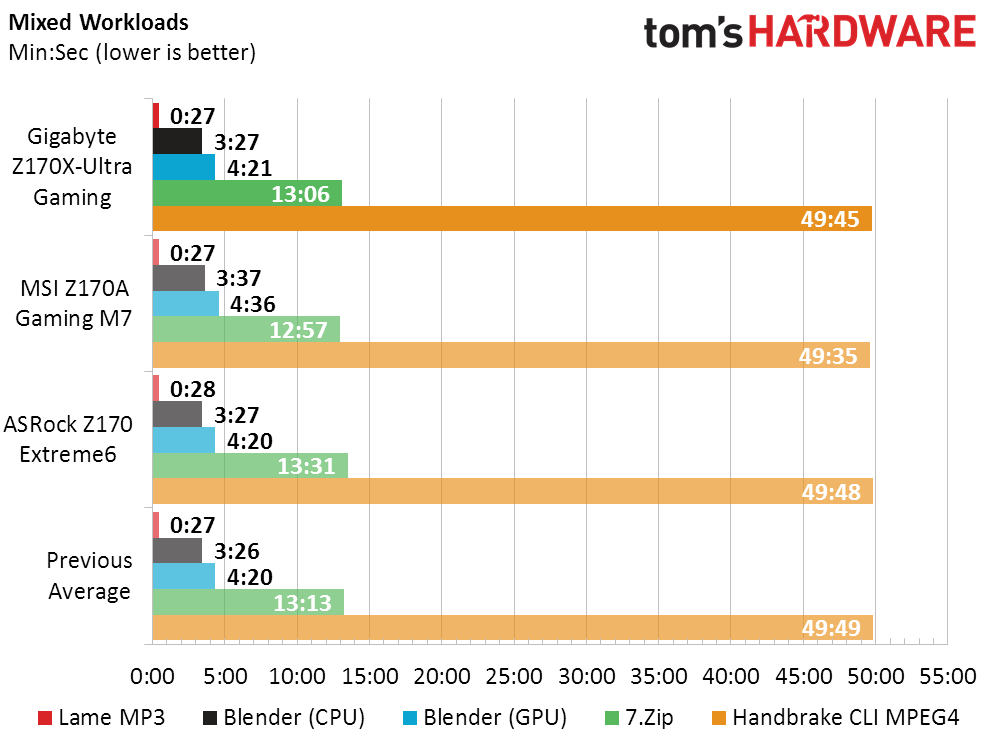


Less time means better performance in timed applications, but we don’t see any overall differences worth noting.
Power, Heat And Efficiency
Hoping to find any place (other than features) for the Z170X-Ultra Gaming to differentiate itself, we finally see that idle wattage is higher. Perhaps the Thunderbolt controller is drawing a few watts? A look at the voltage regulator temperature also shows the effect of full load on a smaller voltage regulator, with higher voltage regulator temperatures explaining the greater difference in full-load power consumption.
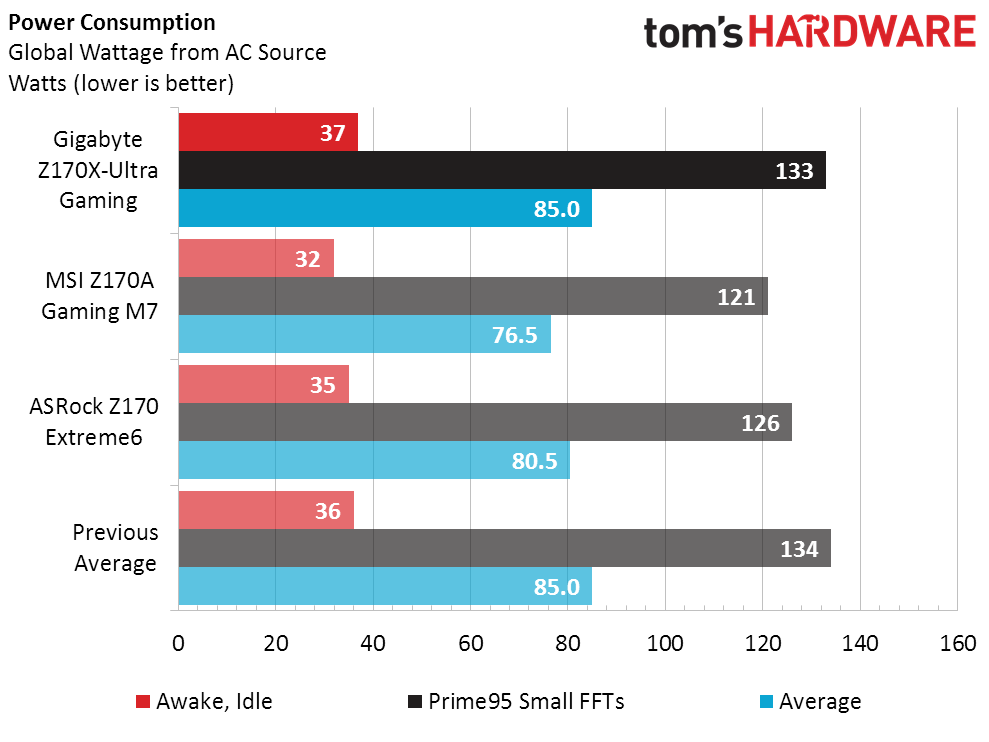
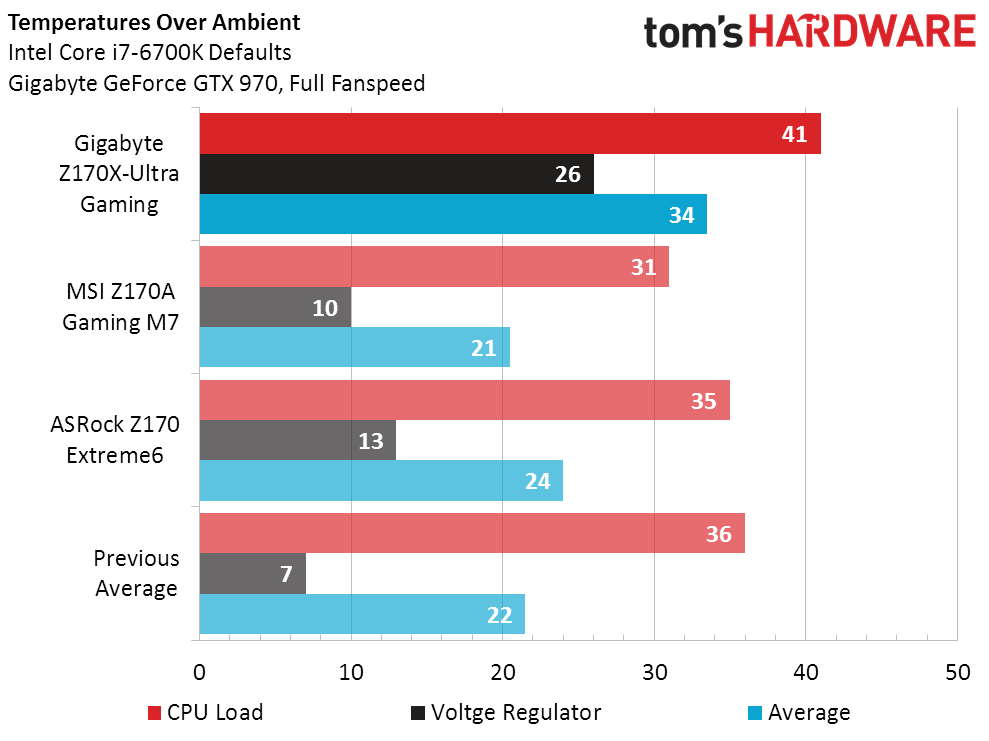
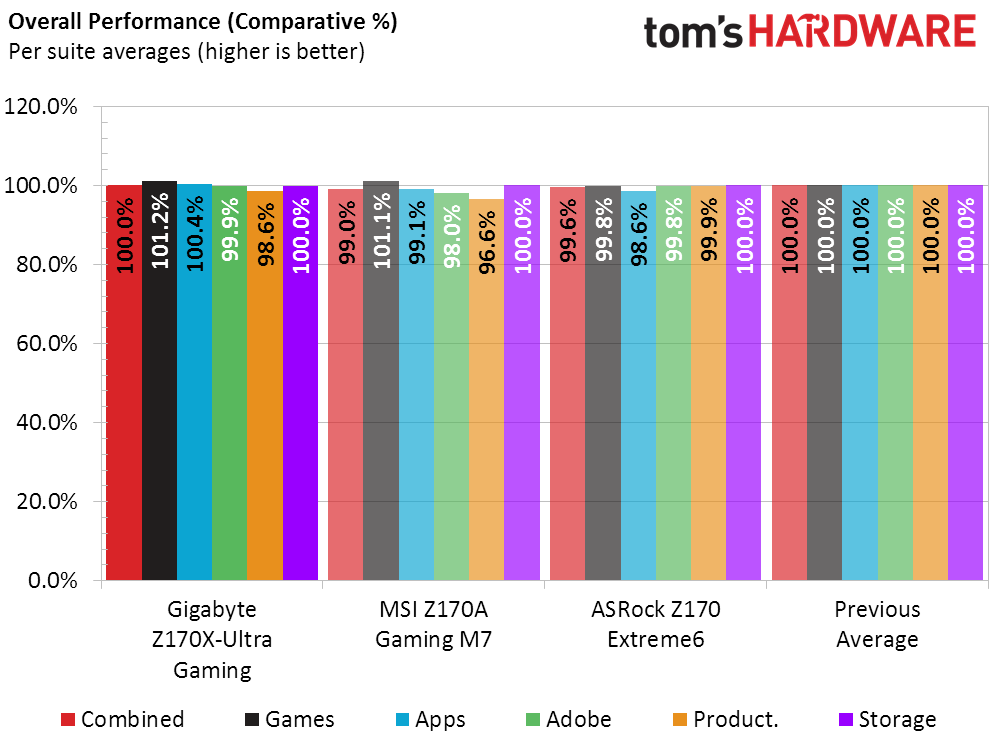

Gigabyte beats both rivals by a nose in performance, but those who think time is money could easily spend that difference on power, since the other two boards exceed the previous average by 5.2% and 10%.
Overclocking
Gigabyte’s Z170X-Ultra Gaming reaches the same 46x 100 MHz setting as ASRock’s Z170 Extreme6. It doesn’t look as good in the chart though, since its 100 MHz BCLK is only 99.65 MHz. Gigabyte also beats ASRock in 2-DIMM overclocking, but lags a little behind when four modules are installed.
I updated the “Performance Per Dollar” chart when the Z170X-Ultra Gaming was $160 and its competitors were $170. Those two competitors have since gone on a wild pricing ride, but I’ll stick with the $170 stopping point for now.
While all three of these motherboards are marketed towards mid-budget gamers, only the Gigabyte Z170X-Ultra Gaming has an expensive Thunderbolt 3 controller. The other two boards have some advancements that look fairly awesome to many gamers, such as upgraded voltage regulators, onboard buttons, and additional USB 3.1 controllers that are just one of the many interfaces supported by Intel’s Thunderbolt 3 controller.
Our power and thermal readings imply that the difference in voltage regulator design isn’t just a matter of whether or not you’ll be able to O/C at well past the 1.30V we chose to preserve our CPU, but that you can also expect a decrease in efficiency. Moreover, these details hint at a completely different strategy in motherboard design. From a component aspect, the Z170X-Ultra Gaming looks like a mainstream design with a high-end feature added, while the others look like mid-priced gaming and overclocking boards that lack any one expensive feature. Value becomes a debate about whether a bunch of small improvements trump a large one, and for Thunderbolt 3 users the answer is probably in the affirmative. The Z170X-Ultra Gaming should appeal more to storage enthusiast and external device geeks than gamers, but perhaps “Geek Edition” didn’t get past the marketing team.
At this point I’d like to give the Z170X-Ultra Gaming our basic stamp of approval, but recent spikes in the prices of its competitors call for something more. As such, the Z170X-Ultra Gaming is graduating to our Recommended award, keeping in mind that the people we’re recommending it to are storage enthusiasts and external device geeks. Gamers who don’t need that Thunderbolt 3 controller would probably be happier not paying for it.
MORE: Best Motherboards
MORE: How To Choose A Motherboard
MORE: All Motherboard Content
Follow us on Facebook, Google+, RSS, Twitter and YouTube.
Current page: Z170X-Ultra Gaming Firmware And Overclocking
Prev Page Gigabyte’s Software Suite-
ledhead11 This MOBO seems to go with the same ideas used in the gen for the x79 I still use. They're not the best, or prettiest but they focus on a very specific set of needs a builder may want while saving some money for other things. I think the price gap between them and competitors will widen even more by the holidays.Reply -
shrapnel_indie ReplyAll three NVMe interfaces steel SATA ports
While steel is spelled correctly, it's the wrong word... the word you're looking for is "steal" as in theft, not "steel" as in a metal that can be used in a case. -
Hupiscratch A suggestion for motherboards review is a Z170 mATX roundup. There are some nice boards with all a gamer or power user could need. The Asus Maximus VIII GENE and the Gigabyte GA-Z170MX-Gaming 5 seems to be good ones to test. SLI/Crossfire could be a concern on this boards.Reply -
Crashman Reply
I think he was being helpful, but I can't get inside that box to change it and don't feel like calling on my boss just yet.18826092 said:To Shrapnel - I suppose you never made a mistake? LOL word Nazi!!
-
shrapnel_indie Reply18826122 said:
I think he was being helpful, but I can't get inside that box to change it and don't feel like calling on my boss just yet.18826092 said:To Shrapnel - I suppose you never made a mistake? LOL word Nazi!!
Yeah, I was just trying to be helpful, not a word/spelling Nazi.I have made tons of mistakes, Sometimes its trying to convince people there is a reason a lowly Pentium has dropped from the best of CPU list for entry-level gaming. They refuse to look past IPS performance and ignore the fact dual core/threaded CPUs choke way more often than not in newer games, despite being faster. (Even when I quote from here, they choose to disregard, as if TH was lying.) I'll be the first to say I'm not perfect, and in many areas,I'm far from it. -
Sam Hain I know it's not a massive increase in FPS/GPU utilization, but come on Gigabyte, no x16/x16? Calling something "Ultra Gaming" with 3 (x16/x0/x4*, x8/x8/x4*) lanes. In other words, no PLX chip like G1's of the past.Reply
I know this would interfere with the M.2 storage option cutting into the lanes, but personally between GPU performance and storage performance options... GPU comes first, especially considering the expense of M.2; RAID'd SSD can be a less expensive option/equally subjectively speedy as I've got bad eyes, LOL. -
Crashman Reply
The 48-lane PLX wouldn't affect M.2 storage because it's 16 to 32 and this board leaves all 16 open to the first slot (or divisible between two slots). The review mentions that the "Gaming" name isn't really appropriate for a board that's basically targeting storage and video production markets, but at least G1 isn't in the model name.18831478 said:I know it's not a massive increase in FPS/GPU utilization, but come on Gigabyte, no x16/x16? Calling something "Ultra Gaming" with 3 (x16/x0/x4*, x8/x8/x4*) lanes. In other words, no PLX chip like G1's of the past.
I know this would interfere with the M.2 storage option cutting into the lanes, but personally between GPU performance and storage performance options... GPU comes first, especially considering the expense of M.2; RAID'd SSD can be a less expensive option/equally subjectively speedy as I've got bad eyes, LOL.
-
Lutfij As always, crashman, this was a well laid out article/review. Much appreciated for making my Monday morning interesting, I mean it! :)Reply -
Sam Hain Reply18833494 said:
The 48-lane PLX wouldn't affect M.2 storage because it's 16 to 32 and this board leaves all 16 open to the first slot (or divisible between two slots). The review mentions that the "Gaming" name isn't really appropriate for a board that's basically targeting storage and video production markets, but at least G1 isn't in the model name.18831478 said:I know it's not a massive increase in FPS/GPU utilization, but come on Gigabyte, no x16/x16? Calling something "Ultra Gaming" with 3 (x16/x0/x4*, x8/x8/x4*) lanes. In other words, no PLX chip like G1's of the past.
I know this would interfere with the M.2 storage option cutting into the lanes, but personally between GPU performance and storage performance options... GPU comes first, especially considering the expense of M.2; RAID'd SSD can be a less expensive option/equally subjectively speedy as I've got bad eyes, LOL.
Thanks fer the clarification!
